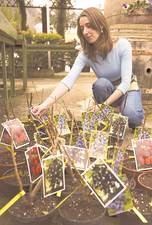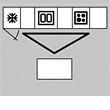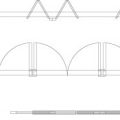 Currant seedlingsThe best place to buyseedlings - small private nurseries that have been specializing in a small set of crops for years, or experimental farms at scientific institutions, where there is a wider choice and you can get advice. If you plan to plant immediately after purchase, buy seedlings with an open root system, and if after some time - with a closed one. Make sure that the roots are not dried out and poorly developed, and the branches - broken. Plants with bare roots should be freshly dug up, the roots are covered with burlap, canvas or polyethylene. When choosing a variety, not only the large-fruitedness and taste of berries are important, but also high winter hardiness, unpretentiousness, resistance to diseases and pests. If a seedling is sold with leaves, then the plant's resistance to diseases can be judged by their color: the leaves should be an intense dark green color. If they have brown-yellow spots and a mealy coating, then the plant is sick and you should not buy such seedlings. The best varietiesBlack currant: "Kipiana", "Grace", "Wonderful moment", "Monisto", "Iskushenie", "Selechenskaya", "Katyusha".Red currant: "Asora", "Valentinovka", "Vika", "Gazelle", "Marmeladnitsa", "Niva", "Osipovskaya sladkaya", "Ustina", «Orlovchanka».White currant: «Belka», «Belyana», «White Potapenko». : "Sadko", "Orlyonok", "Kolobok", "Grushenka", "Northern Captain", "Tender". Honeysuckle: "Nymph", "Morena", "Sibiryachka", "Lebedushka", "Lazurit", "Bazhovskaya", "Long-fruited", "Izbrannitsa". Raspberry: "Beglyanka", "Gussar", «Volnitsa», «Balsam», «Skromnitsa», «Sputnitsa», «Zhuravlik», «Meteor». Large-fruited, the size of a plum, but less tasty and requiring shelter in winter – «Aborigen», «Taganka», «Stolichnaya», «Mirage». Everbearing raspberry, ripening in August – October, right up until the frosts, on the shoots of the current year: "Indian Summer-2", "Hercules", "Apricot", "Augustina". Advantages of autumn planting
Currant seedlingsThe best place to buyseedlings - small private nurseries that have been specializing in a small set of crops for years, or experimental farms at scientific institutions, where there is a wider choice and you can get advice. If you plan to plant immediately after purchase, buy seedlings with an open root system, and if after some time - with a closed one. Make sure that the roots are not dried out and poorly developed, and the branches - broken. Plants with bare roots should be freshly dug up, the roots are covered with burlap, canvas or polyethylene. When choosing a variety, not only the large-fruitedness and taste of berries are important, but also high winter hardiness, unpretentiousness, resistance to diseases and pests. If a seedling is sold with leaves, then the plant's resistance to diseases can be judged by their color: the leaves should be an intense dark green color. If they have brown-yellow spots and a mealy coating, then the plant is sick and you should not buy such seedlings. The best varietiesBlack currant: "Kipiana", "Grace", "Wonderful moment", "Monisto", "Iskushenie", "Selechenskaya", "Katyusha".Red currant: "Asora", "Valentinovka", "Vika", "Gazelle", "Marmeladnitsa", "Niva", "Osipovskaya sladkaya", "Ustina", «Orlovchanka».White currant: «Belka», «Belyana», «White Potapenko». : "Sadko", "Orlyonok", "Kolobok", "Grushenka", "Northern Captain", "Tender". Honeysuckle: "Nymph", "Morena", "Sibiryachka", "Lebedushka", "Lazurit", "Bazhovskaya", "Long-fruited", "Izbrannitsa". Raspberry: "Beglyanka", "Gussar", «Volnitsa», «Balsam», «Skromnitsa», «Sputnitsa», «Zhuravlik», «Meteor». Large-fruited, the size of a plum, but less tasty and requiring shelter in winter – «Aborigen», «Taganka», «Stolichnaya», «Mirage». Everbearing raspberry, ripening in August – October, right up until the frosts, on the shoots of the current year: "Indian Summer-2", "Hercules", "Apricot", "Augustina". Advantages of autumn planting
- Black currants, gooseberries, and especially honeysuckle “wake up” in the spring before the soil thaws, and any planting or replanting harms the plants.
- Growing seedlings in nurseries ends in autumn, so the widest selection is in September.
- Bushes planted in autumn will begin to bear fruit earlier - currants, raspberries and gooseberries in a couple of years, and honeysuckle - in 3-4 years.
Landing features
- Remove all leaves from bare-root seedlings immediately after purchase, but leave them on potted plants.
- To a minimum, reduce the time from purchasing a seedling to planting. Try to meet the end of September.
- Choose sunny, well-lit areas not shaded by trees for planting bushes.
- The average size of a pit in depth and width is50-60 cm. The distance between raspberry bushes in a row is 50 cm, between rows - 2 m. Plant the remaining berry bushes even more spaciously - every 1.5-2 m.
- The less fertile the soil, the wider and deeperthere must be a planting hole. It is filled with a mixture of the top (25 cm) layer of soil with compost or completely decomposed rotted manure from two years ago. In the absence of pre-prepared compost, use purchased organic matter - 4-6 kg of horse humus per bush.
- Place a lump of earth knocked out of the pot on the mound poured in the center of the hole, carefully spread the roots. Then fill the space around the roots with soil, leaving no voids.
- The place where the base of the stem passes into the root,Raspberries should not be planted too deep. On the contrary, black, red and white currants should be planted to a depth of 5-10 cm, gooseberries to 5-7 cm, and honeysuckle to 3-4 cm.
- After planting, cut the raspberry stem to 20-30 cm from the soil surface, and the currant and gooseberry stems to 15 cm. Leave the honeysuckle uncut.
- Plant all plants in moist soil and, if there is no rain, water them weekly until the end of October.









